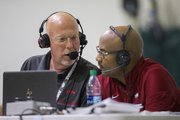FAYETTEVILLE — Eric Swaringen has been an ESPN producer for more than 20 years, but Saturday's broadcast of Arkansas' spring football practice stands out as one of the most challenging events he has produced.
The SEC Network crew had less than 48 hours' notice of the venue and format change - from a typical spring scrimmage inside a spacious football stadium to a routine practice inside a relatively small facility not intended to host television crews.
"We found out Wednesday that they were expecting flooding and rain, and we were able to start adjusting from that point," Swaringen said. "They were able to let us know Thursday night that they were going to move it indoors, so that helped us tremendously. We were able to figure out where we could put cameras and where we can't."
The SEC Network crew spent nearly nine hours Friday setting up inside Walker Pavilion, the Razorbacks' indoor football practice facility. The broadcast included two field cameras and three elevated cameras - two on hydraulic lifts and one on the catwalk above the facility. The production crew also had to create new graphics to describe the on-field drills and adjust when it learned a clock wouldn't be available at the indoor facility.
There were other floating factors, such as how Arkansas coaches planned to have elements of practice inside and outside if the weather cooperated.
The finished product included on-field cameras that gave a first-person view of drills throughout the two hours and mic'd-up sessions with coordinators Dan Enos and Paul Rhoads that provided a snippet into what is heard in offensive and defensive huddles. There also were behind-the-scenes moments and interviews with coaches, current players and prominent former players Steve Atwater and Trey Flowers.
During one point of the broadcast, linebacker Dre Greenlaw - who sat out contact drills while rehabbing from a foot injury - was asked to provide analysis on the next play.
"The will (linebacker) has the first to the flat - nothing there so he just guards the guy over the top," Greenlaw said. "He got a pick! That was a good job by Scoota (Harris)."
The broadcast took a turn when Rawleigh Williams was injured about 20 minutes into the practice and had to be carted off the field. Swaringen, whose past included producing NHRA broadcasts, said he is used to making a split-second decision whether to show an injury.
"You don't want to go in too tight with the cameras and see someone in pain," Swaringen said. "After I looked at the replay...the angle we had of him getting hit didn't look like something that's going to make you cringe. I decided to show one angle of the replay real speed, not slow motion. I wanted the viewers at home to be able to see that."
Much of the subsequent minutes were spent switching between shots of paramedics tending to Williams, family members consoling one another and coaches and players kneeling. Some of the cameras were able to pick up audio of Arkansas coach Bret Bielema leading the team in a prayer while Williams was loaded into an ambulance.
"I thought we were able to tell the story," Swaringen said.
Meanwhile on the radio, Arkansas football voice Chuck Barrett and partners Quinn Grovey and Geno Bell tried to fill two hours they originally thought would be a running account of a scrimmage.
If a last-minute change is hard on TV, it is doubly as difficult on radio.
"A stormy day in the Ozarks has moved the Razorbacks inside for the final practice of spring drills," Barrett said as he led off his broadcast.
"We're going to describe to you what we're seeing on the field. There will be some one-on-one drills and there will be some of this broadcast that amounts to pseudo play-by-play."
The first block of the broadcast was spent with Barrett, Grovey and Bell recapping last season and giving a rundown of key off-season storylines. The second and third blocks were filled with a pre-recorded interview between Barrett and Bielema, and the rest could be described as sports talk radio.
"It was impossible to do a traditional two-hour game broadcast, so we just kind of did a radio show from spring practice," Barrett said. "It was unusual.
"We were committed to doing it so we felt like we needed to do it. Geno was working with us and we felt like it would be a good opportunity for him to get some mic time. Sometimes you've got to do it on the fly and that's what we did."
Like the TV broadcast, the radio broadcast had in-practice interviews and plenty of talk about the Razorbacks' end to 2016 and prospects for the 2017 season. Barrett interrupted some conversations for brief accounts of what was happening on the field.
"Hey, there's a pick six on the other side," Barrett exclaimed late in the broadcast. "Ryan Pulley just picked off Cole Kelley and took it back about 40 yards."
That shifted the conversation back to more speculation - how good Pulley could be and whether Kelley would become the No. 2 quarterback.
"It was different than what I anticipated," Barrett said. "But you know, Quinn and I did a pregame show together for several years. That's really what this was if you want to get right down to it. From that standpoint, it was very easy."


